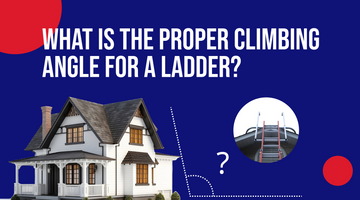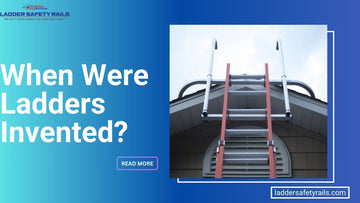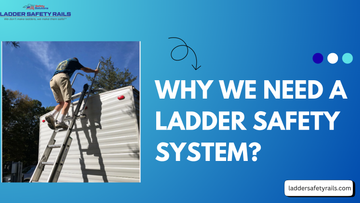
One of the most crucial aspects of using a ladder correctly is positioning it at the proper angle. A ladder that isn’t set up with the right climbing angle can lead to serious accidents, regardless of how experienced you are.
Before climbing a ladder, it’s important to assess its setup and overall safety. Ensuring your ladder is at the correct angle should be a priority. An extension ladder, for example, needs to be positioned at a precise 75.5-degree angle. While this may sound technical, there are simple methods and tools you can use to ensure your ladder is set up correctly, giving you peace of mind when climbing a ladder.
Why the Proper Climbing Angle is Critical for Safety
The key to using ladders safely is understanding how to set them up properly. If the ladder’s base is too close to the wall, the ladder becomes too steep, increasing the risk of it tipping backward. On the other hand, if the base is too far from the wall, the ladder becomes too shallow, reducing stability and making it prone to slipping.
When the climbing angle is correct, you are better positioned to maintain balance and prevent falls while climbing on a ladder. A stable and correctly angled ladder is much safer to use, and there are plenty of tools and techniques available to help you achieve this ideal setup.
Tools to Help You Find the Correct Climbing Angle
Here are some tools and methods that can help:

The NIOSH App:
The National Institute for Occupational Safety and Health (NIOSH) has developed an excellent app that offers practical ladder safety tips. This app not only includes detailed instructions on how to conduct a ladder inspection, but it also has a feature that helps you find the correct climbing angle for your ladder.
It’s simple to use: open the app on your smartphone and place the phone on one of the ladder’s rungs. The app will then analyze the climbing angle and tell you if you need to adjust it, either by making it more steep or less steep. This kind of technology is a game-changer for ensuring ladder safety and reducing accidents.
The 4-to-1 Rule for Ladder Safety:
According to this guideline, for every four feet of ladder height, the base of the ladder should be placed one foot away from the wall. For example, if your ladder extends 16 feet in height, the base should be four feet away from the wall.
This method ensures that your ladder is neither too steep nor too shallow. Following the 4-to-1 rule can significantly improve ladder safety and help you avoid accidents when you climb the ladder.
Additional Ladder Safety Tips
In addition to finding the right climbing angle, there are other ladder safety tips that you should follow to make sure you stay safe:

-
Inspect the Ladder Before Use:
Always check your ladder for any signs of damage, including cracks, missing rungs, or loose hardware. A damaged ladder is more likely to fail when in use, increasing the risk of accidents.
-
Secure the Ladder Properly:
Make sure the ladder is placed on a flat, stable surface before you start climbing a ladder. Avoid slippery or uneven ground, which can cause the ladder to shift or tip over.
-
Don’t Overreach:
When you’re on the ladder, avoid leaning too far to one side. Overreaching can throw off your balance and cause the ladder to tip over.
-
Use a Ladder Safety System:
Many modern ladders come with ladder safety systems like stabilizing bars or grips, which can enhance the ladder’s stability and reduce the risk of accidents.
The Importance of Ladder Stabilization
Now that you know how to find the proper climbing angle for a ladder, it’s also essential to remember that keeping the ladder stable is just as important. Even if you set the ladder at the correct angle, an unstable base can still lead to accidents. That’s why using a ladder safety system like a ladder stabilizer is highly recommended, especially when working on uneven or slippery surfaces.
A ladder stabilizer, such as those offered by Ladder Safety Rails, can significantly improve ladder stability. These stabilizers provide additional support to keep the ladder securely in place, preventing it from slipping or tipping.
Conclusion
By following this guide, you can always make sure your ladder is at the correct climbing angle. But don't forget: in addition to positioning the ladder at the right angle, maintaining its stability is equally important.
Using a ladder stabilizer, available at Ladder Safety Rails, can help ensure your ladder remains secure, minimizing the risk of falls and injuries. Prioritizing ladder safety by following these guidelines will help you work more confidently and efficiently, whether at home or on the job.

FAQs
-
What is the best climbing angle for a ladder?
The best climbing angle for a ladder is 75.5 degrees. This ensures the ladder is positioned safely for stability and prevents slips or falls.
-
What angle should a ladder be put up at?
A ladder should be set up at a 75.5-degree angle for optimal safety, ensuring it is neither too steep nor too shallow.
-
What is the 4 to 1 angle rule for ladders?
The 4-to-1 rule means placing the ladder’s base 1 foot away from the wall for every 4 feet of ladder height to achieve the proper climbing angle.
-
Is the proper angle for a ladder 75 degrees?
Yes, the correct angle for a ladder is approximately 75 to 75.5 degrees, ensuring stability and safety during use.
Read More Blogs:






